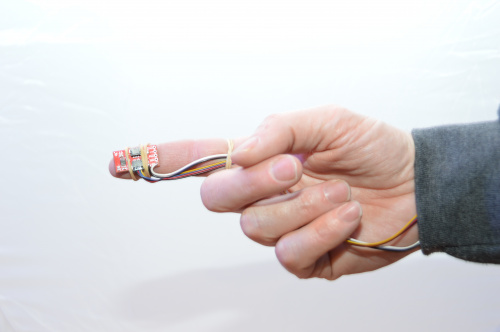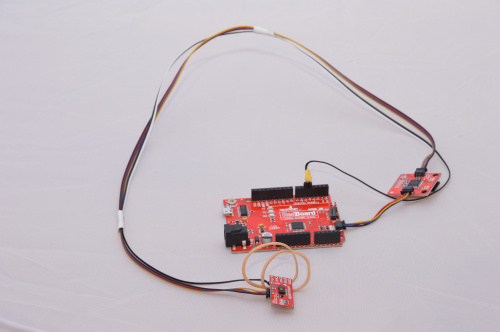I have been active for the bulk of my life - doing team activities like lacrosse and wrestling, and more individual activities like rock climbing, parkour and cycling - but the one thing that brings me no joy is running. Regardless of how much or how well I train, I seem to be unable to increase my endurance to anything that might prove even remotely beneficial during the zombie apocalypse (don’t forget rule #1).
Unfortunately with things the way they are now, more isolated activities like running seem to be playing a larger role in my life. While suffering through a recent morning run, I found myself contemplating just why running kicks my butt so hard. My thought was that perhaps it has something to do with the half dozen times my nose was broken. The first break was a lacrosse injury, moving my nose from the center of my face to somewhere under my right eye. The surgeon moved it back to about the middle of my head, but that and subsequent breaks left me with a severely deviated septum and an intake capacity of somewhere around half of what it should be. Could this be hindering my O2 intake enough that it has this profound an effect on the blood oxygenation? If only there was a way I could find out...like with the Pulse Oximeter and Heart Rate Sensor.
The Pulse Oxygen and and Heart Rate Sensor, attached with the greatest of care, to my finger
The build
I wanted a fast and simple build, since I had a day and a half before we were predicted to get our next snowfall. I grabbed a Pulse Oximeter and Heart Rate Sensor, Qwiic OpenLog and a Redboard Qwiic. I had to do a little soldering, as the sensor is not a straight-in Qwiic sensor, even though it does use the Qwiic connectors for its I2C communication. It also requires two other lines to be fully operational.
The setup, with a 500mm Qwiic cable to allow the Redboard to be placed further up my arm.
The code
The code here is a simple mash-up, a little from column A and a little from column B. I started with the basic example from the pulse ox sensor, as that is the more in-depth code. That’s usually my M.O. when combining sensors or breakout boards - start with the most, so you’re only adding the least. In this case it was as simple as changing Serial.println(variable); to myLog.println(variable);. Well alright, there is indeed a bit more to it than that, but you get the idea.
The Results
There’s no way around it: I’m going to have to go for a run. For reasons I cannot explain nor am I proud of, I had the armband from an old MP3 player sitting on a shelf right across from my desk. I have no idea why I still have it, since I’m pretty sure the MP3 player for which it was designed no longer exists. But it seems perfect for this application. Since this is for science, I wanted to get a baseline. So the first thing to do is just sit here. You know, for science. Over the course of two minutes, my baseline readings averaged 57 BPM, with a pulse ox of 99. Then I hit the streets.
Trying to get this run in before that snow gets here
Here’s what I learned. No matter how careful you are, or how well you fasten the Pulse Ox sensor to your finger (without it being too tight), the motion of your arm has an extremely adverse effect on the readings. For my first run, I wound up with a few readings in the beginning, followed by three minutes of no readings at all, and then a few readings at the end when I stopped to turn the monitor off. I tried a few more things, and finally had to do sprints. I did twenty second sprints, then stood still for ten seconds to get a few readings, then sprinted some more. Even with that, the result surprised me. My Sp02 never dropped below 94 percent. Being a little confused but a lot curious, I dug through a few white papers on the subject, and learned that according to some research, Sp02 levels don’t drop significantly until the heart rate hits about 175 BPM. Looking at my data, it appears that during this experiment, mine never got above 162.
Interestingly enough, and in the name of science and current events, I also took a quick run without a mask, and there was absolutely no difference in my blood oxygen saturation between the two runs (so wear a mask!).
You can see when I was running and when I stopped to get a reading.
The takeaway
I guess in the end, this just leaves me with more questions. Did having my nose smashed into my face so many times that my ENT can’t even insert a scope to do a flexible laryngoscopy make it harder for me to get enough oxygen? Do I regularly get my pulse above 175 when running for real, but not during a sprint experiment? Should I just do the Usain Bolt thing, and never even try to run a mile? What do I do with the information I did collect? I don’t suppose my insurance will cover a rhinoplasty for medical reasons, even if I explain that it’s crucial to my current scientific experiment involving blood oxygenation and SpO2 decline over time under exertion (that sounds officially scientific, right?). In the meantime, I’ll just keep running until I’m comfortable getting back in the parkour gym, or the rock gym, or anyplace else where I can disguise exercise as playing!










You didn't mention it, but have you ever been evaluated for asthma? I've had it my whole life, and wasn't able to run without getting winded (and then staying winded for a while after) until I got the right inhaler steroid. I started running with a friend and was able to get to the point where my lungs and heart were conditioned so that I was able to get to the "runner's high". People had talked about it, but I could never achieve that breakthrough moment when you get that high and your lungs open up and work. It might not be your issue, but you might want to check. If you're here in Colorado, National Jewish Hospital is pretty amazing for asthma related stuff. Boulder Valley Allergy and Asthma is good too, I see Dr. Mark Menich who is an awesome doc.
The main challenge with running is achieving efficient running form. The best tool for this is video. Cameras that follow you can show running form.
I agree with the doc that an ear clip would likely work better while you're running - that's what I used for years while training on stationary bikes and they always seemed more accurate and secure.
On a training note... are you working to build endurance, or just running by feel? An endurance-focused training plan that is based on heart rate zones would likely help you build to the point where you could do longer runs without getting winded. I run ultras (over marathon distance) races, and it takes time (months or years, not weeks) to build to the point where you can sustain a HR of 150+ for hours at a time.
Or, maybe you're mostly fast-twitch, and simply better suited to sprint sports, like lacrosse!
I've worked on the medical side of this issue for decades (retired respiratory doc) Three comments: 1) The vast, vast majority of people will become obligate mouth breathers with a heart rate in the 160s. Broken nose or not, you simply can't get enough air in to sustain metabolism nose breathing when running. (That's why US football players work so hard at developing maximum muscle efficiency when doing downfield sprints-- they can't open their mouths because of the tooth guards.) 2) Thank you so much for supporting masks. A cloth or paper mask (not N95, different creature) places a minimal resistive element in the air path, particularly if mouth breathing. It may feel uncomfortable, because of retained humidity, etc. Unless you are an absolute world class athlete trying to break a world record, it won't matter that much. 3) your problems with getting a good, steady biologic signal to analyze are not surprising. This is where mechanical design is much more important than the electronics. The sensors and electronics have been around forever and simply work. Getting a good, stable attachment to the finger that will survive activity is hard (if you can keep your ears warm, consider an earlobe clip instead!) Most exercise systems also have software that does some noise and artifact rejection. Thanks for an interesting read!!
Thank you so much for your input and kind words. I expect to hit my ventilatory threshold at some point, of course, but it just happens much sooner than I would like. I'm looking for a reason (or excuse), but it might just be because I'm not 22 anymore!
FWIW, I'm starting to get back on my feet (literally) after a broken leg in a car accident. I'm using a walker (due to a genetic bone ailment, I've never been able to run), and get tired (winded) to the point of needing to sit down about every 75 feet or so. (Due to needing to put a fair portion, maybe 30%, of my weight on my arms, they get tired before my legs do.) Although I've had many broken legs before, I've never had any broken noses. I got curious a few weeks ago, and carried first a BP monitor, and then a pulse oximiter, with me and used them at every rest stop. Other than my pulse getting up to about 110 BPM (which my Apple watch can show), I have no other numeric evidence of my exhaustion. I'm generally back down into the 80s on BPM by the time I'm feeling up to proceeding.
BTW, on the subject of "MP3 players", I was out of college and working as an engineer for several years when the first Walkman hit the streets (if you're too young to remember it, it played cassette tapes). I'm now on Medicare...
Oof, I'm so sorry to hear about your leg and your car. I DO remember the Walkman! In fact, one of my earliest "inventions" was hacking a cassette case by adding a small propeller and some type of drive shaft through the wall of the case, so I could put in a cassette and rewind it just by holding it out the window of a moving vehicle. That way I wasn't wasting batteries or spinning the cassette on a pencil!
Hope you were the passenger, and not the driver, when holding it out the vehicle window! It does sound like a creative solution, for sure!